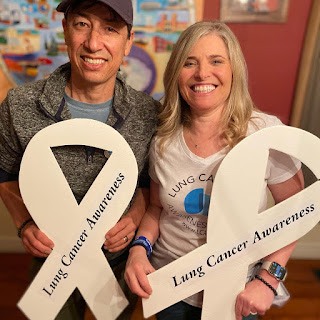Targeting Mutations in Lung Cancer: EGFR
As I’ve previously written, the most useful biomarkers for
predicting the efficacy of targeted therapy in advanced NSCLC are genomic
alterations known as "driver mutations." These mutations occur in
cancer cells within genes encoding for proteins critical to cell growth and
survival. Through the use of molecular testing, the discovery of genetic
mutations that drive NSCLC is rapidly improving the outlook for some patients
in stage 4 disease. This is significant because almost 40% of lung cancer
diagnoses are stage 4 patients. One of the first breakthroughs was the
discovery of the EGFR (epidermal growth factor receptor) mutation, which is
present in about 10 percent of patients who are diagnosed with lung cancer in
the United States (interestingly more common in patients with adenocarcinomas
and no prior history of smoking, as well as in women and those of Asian descent).
I remember being at the American Society of Clinical
Oncology (ASCO) conference in 2004 and the buzz surrounding a drug called
Gefitinib (Iressa). The FDA had approved Iressa in May of 2003 for treatment of
Non-Small Cell Lung Cancer (NSCLC) and it was notable that in clinical trials the
drug worked spectacularly well in about 10% of lung cancers patients but failed
to help the rest. No one could figure out why. Then researchers figured out
that most people who responded to Iressa had similar genetic mutations in their
tumors. A later study extended the findings in EGFR research to a related drug,
Tarceva, which was awaiting approval by the FDA.
The two groups of Harvard researchers, one at Massachusetts
General Hospital (MGH) and one at Dana
Farber Cancer Institute did a deep dive into the data regarding lung tumors
from patients who responded to Iressa and those who did not. Most responders
had the EGFR mutations. Non-responders did not. The laboratories began offering
a test to detect the mutations and scientists speculated they could become
widely available in the near future. MGH had a clinical trial that was testing
patients for the mutations as a predictor of their response to Iressa as an initial
treatment. Iressa wasn’t usually the first option; it was typically given to lung
cancer patients who didn’t respond to chemotherapy. Now that scientists could
explain the drug’s effectiveness in some cases, there was hope that they could
better predict who would respond to them in the future and that lessons from
Iressa and Tarceva could be applied to other cancers. This is when targeted
therapy began to become a reality.
Iressa and Tarceva are part of a relatively new class of
drugs known as targeted drugs, which are different from traditional
chemotherapy drugs because they are designed to specifically hit cancer cells.
Unlike chemotherapy drugs which kill healthy and cancerous cells, targeted
drugs are supposed to kill only cancer cells. Until the mid-2000’s, treatment
options for lung cancer were mostly limited to surgery, chemotherapy and
radiation. Now, people diagnosed with lung cancer have newer, more personalized
treatment options. The goal of targeted therapy is to accurately target your
individual tumor, which hopefully leads to more effective treatments and less
side effects.
Thankfully screening has become an increasingly standard
part of the diagnostic work-up for NSCLC, and is useful in choosing between
standard chemotherapy and targeted therapies. EGFR-targeting drugs — which
include Tarceva (erlotinib), Iressa (gefitinib) and Gilotrif (afatinib) — are
now used in the first-line treatment for metastatic lung cancer patients. Patients
are able to get a treatment that matches the mutation that has been identified
through a molecular test of their tumor. While most lung cancer patients with
EGFR mutations who respond well to targeted treatments ultimately develop
resistance to the drugs after a year or so as the cancer finds other ways to
grow, newer drugs are being evaluated to be used as second-line treatments.
This is why it’s important to have tumors continuously tested during treatment
to detect different mutations that evolve during treatment. For example,
Tagrisso (osimertinib) is approved for patients with a specific EGFR mutation
called T790M who relapse after being treated with a different EGFR drug. A
similar drug called rociletinib (CO-1686) is in late-stage trials in patients
with the T790M resistance mutation.
I saw first-hand this process of genetic testing, and the
resulting treatment when a good friend of mine was diagnosed with stage 4 lung
cancer. He went to the hospital and started chemotherapy treatment. Within 24
hours he was on a ventilator fighting for his life and not responding to the
chemo. Test results showed that he had the EGFR exon 19 mutation and his
regimen was immediately changed from chemo to Tarceva. He started responding
and was off the ventilator breathing on his own within 2 days. We were all
blown away with how quickly he responded to the targeted treatment. While unfortunately
in his case it was too late to save his life, it did show me how remarkable the
response was to a targeted therapy. It also convinced me that every cancer
patient deserves to get molecular testing to identify the best course of
treatment, which may be a targeted therapy such as Tarceva.
#CancerResearchEvangelist
#PrecisionMedicine
